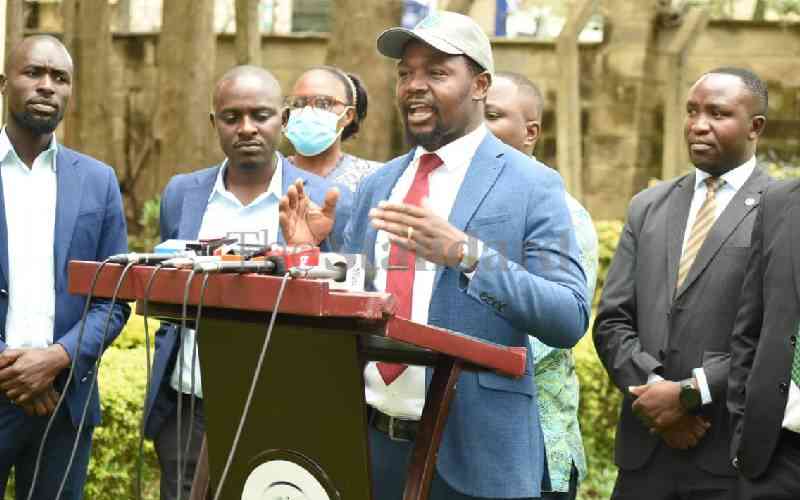Today, the Government will tell Kenyans that the country has hit a target it thought it would reach in 16 years’ time: Kenya is now a middle-income economy.
The country has achieved its grand dream by bringing in the contribution of services like M-Pesa into the calculations of the value of goods and services produced annually.
The reclassification duly acknowledges sectors of the economy that have contributed to growth in more recent years, such as ICT. These had been left out of calculations on the size of the economy because statisticians used an outdated basket of goods and services.
Under the new calculations, the value of goods and services Kenya produces — what is referred to as Gross Domestic Product — is at $52.8 billion (Sh4.7 trillion), up from $44.1 billion (Sh3.9 trillion).
This makes Kenya’s new wealth about double the estimated worth of China’s richest man, Jack Ma, whose net worth is $25 billion (Sh2.2 trillion). Ma’s company, Alibaba, just posted the world’s biggest public share offer.
So with the newfound status, is the pressure off to meet the aspirations set out in the often-quoted blueprint, Vision 2030?
Not quite.
The use of the term ‘middle-income economy’ is intended for convenience; it does not imply that economies under this category have similar development indicators (such as poverty levels or growth performance) or have reached a preferred level of development.
The classification is only one of the statistics that define a country’s economic performance. There are other numbers that matter, such as unemployment rates, cost of living, income inequalities, forex earnings, and energy, water and health access levels.
The World Bank’s classification of middle income is set at between $1,036 (Sh92,400) per person per year and $12,615 (Sh1.1 million).
In Kenya’s case, it only indicates the country has gotten richer in per capita terms — that is, overall wealth divided by our population of 44.3 million, according to World Bank estimates, to calculate the value per person.
But to illustrate how the middle-income status only tells half the growth story, consider that globally, most of the world’s poor no longer live in poor countries.
An estimated 72 per cent of poor people — those on less than $2 (Sh178) a day — now live in middle-income countries, with only a quarter living in low-income countries.
Just 20 years ago, 93 per cent of the world’s poor lived in low-income countries.
Blurred lines
Stay informed. Subscribe to our newsletter
But even with this new status, the outlook for Kenya’s economy remains blurred, and policy makers, analysts, economists and fund managers will continue scrambling to find strategies that will stimulate growth and put actual wealth in more people’s pockets.
High public spending, a weakening shilling exchange rate, high cost of living, dwindling forex earnings from tourism and key exports, erratic weather patterns and insecurity have seen growth forecasts for this year trimmed to 5 per cent from 5.8 per cent.
The Treasury is wary of public expenditure pressures, largely linked to the ballooning public sector wage bill and the cost of implementing the Constitution that provides for a devolved system of government.
“And even the referendum we are hearing about can stress our fiscal position severely if we start going in that direction,” said National Treasury Economic Secretary Geoffrey Mwau.
According to Dr Mwau, however, the new status will not see the Government relax its efforts to revive the economy.
Some of the measures being rolled out include promoting domestic tourism through holiday incentives, payment of outstanding income tax refunds to hoteliers, and diversifying tourist markets to China and Eastern Europe.
“We expect fairly strong growth in 2014 and in the medium term,” said Mwau.
Other measures to accumulate growth over the medium term, he added, would improve the competitiveness of the economy, reduce the cost of living, reduce unemployment among the youth and women, and strengthen the devolution process.
But some economic analysts remain concerned.
“The economy appears to be in auto-pilot mode and a lot of things are not going right. We are spending more time on allocating public spending than on adding value for this expenditure,” said Emmanuel Manyasa, an economist at Kenyatta University.
“Why should we be spending money to put up offices for Members of the County Assembly (MCAs) instead of using it to hire nurses? Our focus is mostly on the political sector, which has no immediate value for money.”
Trade concessions
There also those who worry that certain trade concessions, grants and preferential treaties will be revoked now that Kenya is no longer a low-income economy.
Other analysts, however, are optimistic that Government projects in the pipeline will soon see the economy improve, increasing national income and negating the effects of losing these concessions.
“The cost of living is on the rise, the exchange rate is worsening and insecurity is a big problem, but these are not conditions unique to Kenya,” said Rita Kairu, an economist at the University of Nairobi.
“What we need to do as a country is put in place measures to minimise any negative consequences on the economy.”
And one of the big issues that needs be addressed is the growing pile of commercial disputes pending in court that are denying the economy billions of shillings in investment and trade.
The list of development projects whose fate hangs in the balance includes the Sh327 billion standard gauge railway project, Sh24 billion laptop project and the Sh170 billion coal plant project in Lamu.
There are also a number of public projects that were designed during former President Mwai Kibaki’s tenure that President Uhuru Kenyatta’s Government has yet to complete or initiate.
These include the standard gauge railway, though its construction is set to begin next month — a year behind schedule — and the dualling of the Ngong Road, financed by the Japan International Co-operation Agency (JICA) at Sh1.67 billion.
Business leaders have blamed the delays in project implementation on lengthy procurement processes, legal and contractual issues, delays in the disbursement of funds and the noisy political environment.
Kenya Private Sector Alliance (Kepsa) CEO Carol Kariuki added that the delays in rolling out the initiatives that would lower the costs of doing business are affecting investors’ eagerness to set up in Kenya.
“In some areas, the Government is facing challenges in terms of land grabbing as public land has been completely taken over by private developers. The purported beneficiaries always rush to courts to seek legal redress against the Government whenever it moves to reclaim the resource. The legal suits take long to be determined, delaying public projects,” she said.
For instance, despite JICA providing the financing, the expansion of Ngong Road in Nairobi has stalled for more than two years as the Government is yet to create space to allow for the execution of the project.
Also, part of the 28.6-kilometre southern bypass from Mombasa Road to Wilson Airport is yet to kick off due to a lack of adequate land.
But National Treasury Cabinet Secretary Henry Rotich defended the pace at which projects are being implemented, saying some factors are beyond Government control.
“Yes, some of the projects have been delayed, causing anxiety in the country. However, we are keen to ensure the projects take off for the country to benefit, mainly in terms of facilitating the business community and safeguarding taxpayers against further losses,” he said.
According to Terry Ryan, the chairman of the Kenya National Bureau of Statistics (KNBS), the anxiety is further fuelled by current domestic and external shocks the economy is facing, which are making growth levels beyond 6 per cent difficult.
Prof Ryan cited the lacklustre performance of the agriculture and tourism sectors, and slow economic recovery of the Eurozone among the major hurdles in Kenya’s way.
Unresolved issues
The country’s economic growth slowed to 4.1 per cent in the first quarter of 2014 from 5.2 per cent over a similar period last year.
This was mainly due to erratic weather that hit the agriculture sector, rising insecurity, increased costs of living and travel advisories from key tourist hubs.
A lot of these issues remain unresolved even as the Kenya Revenue Authority hopes to collect Sh1.12 trillion in the 2014/2015 financial year — up from Sh963.8 billion the previous year — by leveraging on technology, innovative practices and implementation of staff performance improvement measures.
This amount comprises Sh1.05 trillion of Exchequer revenue, with agency revenue of Sh65.5 billion.
Already, the Government is staring at a Sh342.6 billion financing deficit in the current financial year, with flashing signs that it might be an arduous task to finance the Sh1.8 trillion Budget.
Further, despite monetary authorities keeping a keen eye on inflation, interest and exchange rates, the economy continues to experience increased inflationary pressures that are now beyond the threshold set by the Central Bank of Kenya.
“Inflation is rising, but I don’t think it is going to get out of control. GDP growth has been moderate but lower than expected due to a shortage of rainfall and delays in launching large infrastructure projects. This is going to put pressure on growth numbers for half of 2014,” said Eric Musau, a research analyst at Standard Investment Bank.
Exports also remain constrained, creating a widening gap in the country’s current account. However, analysts are optimistic the country will attract more capital once pending infrastructure projects are rolled out.
Low productivity
“The Government must now target spending towards the right areas, especially those long term in nature, including reducing the reliance on rain-fed agriculture and costs of electricity,” said Mr Musau.
While low productivity has affected the performance of Kenya’s key agricultural commodity exports, the main concern in agriculture for many is the impact of the expiry of Economic Partnership Agreements (EPAs) between the European Union and East African Community.
“This trade instrument is yet to be ratified even if finalised before the (September 30)deadline, it poses challenges for exports, both in terms of requiring more detailed documentation and introducing higher tariffs,” said Musau.
Tea prices have also edged lower as a result of oversupply in traditional markets.
“This has seen Central Bank boost reserves to cushion the economy. Oil prices are also declining, which will ease the pressure on these [current account] negatives,” said Musau.
Aly Khan Satchu, the CEO of Rich Management, also applauded efforts to keep macroeconomic movements steady.
“I feel that the rate of inflation has already peaked for the year and that Central Bank did well to move to control its monetary policies and, therefore, deserves credit for that. Central Bank is trying to wrestle credit lower, and a pre-emptive rate hike would have polluted that message,” he said.
The shilling has been exhibiting what analysts describe as “Teflon” characteristics, meaning it has remained admirably hardy in the face of negative data.
“Because tea and tourism receipts have slumped, the Eurobond proceeds, for now, are offsetting that hard currency slump. However, we will need a recovery in tea and tourism in 2015,” said Mr Satchu.
In its latest economic update on Kenya released in June, the World Bank forecast a growth rate of 4.7 per cent in 2014 and said the economy has the potential to achieve a growth rate of 5 per cent over the next two years.
The economic update, titled Take off Delayed, noted that higher growth would depend on macroeconomic stability and credible policies, which have underpinned Kenya’s growth in the past. It added that the current growth is fuelled by strong consumption and investment.
Emerging pressures
However, the report said, the Government needs to deal with emerging pressures on GDP — including drought, insecurity and fiscal expansion — for the economy to remain resilient, and to strengthen medium-term growth prospects.
Diarietou Gaye, World Bank’s country director for Kenya, added that the economy remains fairly resilient, and increasing investments in infrastructure and human capital would strengthen prospects for higher growth and regional competitiveness.
The World Bank has launched a $4 billion (Sh356.8 billion) programme under its Country Partnership Strategy 2014-2018 (CPS) to support Kenya’s development over the next four years.
The strategy will enable Kenya improve its potential for growth, create more jobs for the youth, build vital infrastructure and deepen devolution to increase prospects for ending extreme poverty.
Additional reporting by Nicholas Waitathu.
 The Standard Group Plc is a
multi-media organization with investments in media platforms spanning newspaper
print operations, television, radio broadcasting, digital and online services. The
Standard Group is recognized as a leading multi-media house in Kenya with a key
influence in matters of national and international interest.
The Standard Group Plc is a
multi-media organization with investments in media platforms spanning newspaper
print operations, television, radio broadcasting, digital and online services. The
Standard Group is recognized as a leading multi-media house in Kenya with a key
influence in matters of national and international interest.
 The Standard Group Plc is a
multi-media organization with investments in media platforms spanning newspaper
print operations, television, radio broadcasting, digital and online services. The
Standard Group is recognized as a leading multi-media house in Kenya with a key
influence in matters of national and international interest.
The Standard Group Plc is a
multi-media organization with investments in media platforms spanning newspaper
print operations, television, radio broadcasting, digital and online services. The
Standard Group is recognized as a leading multi-media house in Kenya with a key
influence in matters of national and international interest.










